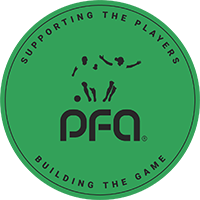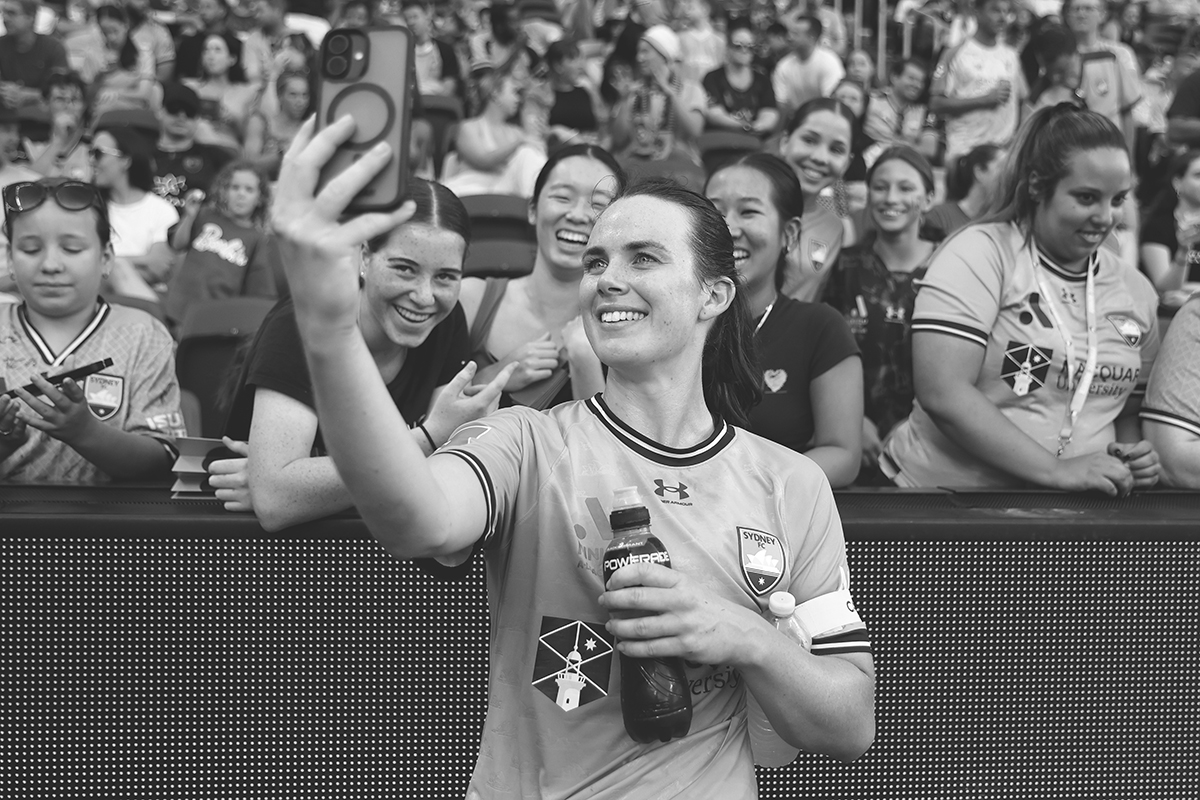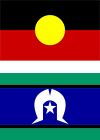Introduction
In 2024, the PFA embarked on a round of extensive research to understand the trajectories of the A-Leagues, the size of the opportunities, and areas for reform. Obviously, a key area of focus was the leagues’ relationships with fans. The PFA engaged leading sports intelligence agency Gemba to conduct market sizing and a mass fan survey. Separately, the PFA conducted its own ‘mini’ fan focus groups with fans (current, potential, or lapsed) of the two leagues. This report summarises the findings of the A-League Women (ALW) focus groups.
The ALW focus groups were held in June, 2024. The PFA targeted participants who were recently converted Matildas fans, with a view to understanding emerging women’s football fandom in Australia and the opportunities for domestic club football. The logic of this targeted approach was that this group represents a new and less-understood potential segment of the ALW fanbase. Two months after the focus groups, an interview with WSL chief executive Nicki Doucet was published in which she said her organisation’s own market research had identified three distinct segments.1 The third segment she described is remarkably consistent with the cohort captured through this study. So this research should be understood to provide a deep insight into one important segment, while recognising that there are other segments that may have different attitudes. As a byproduct of the approach, the first half of this document can be taken as a standalone analysis of what has contributed to the phenomenal increase in Matildas support.
The PFA reached out through staff contacts and fan networks to recruit participants. Twelves Matildas fans participated across three ‘mini’ focus groups. These fans ranged from low to high engagement with the ALW. The participants were all women, not by design but because they were the only suitable candidates available to attend. There was a broad range of ages, but a common profile was middle-aged with teenaged children. Several identified as being from the LGBT+ community.
The focus groups were structured in two parts. In the first half, the fans were asked to describe their conversion into Matildas die-hards. The second half focused on their perceptions of the ALW. The conversations were analysed to identify consistent themes or aspects discussed by multiple participants. Twenty-six resulting insights have been organised into nine categories, as shown in the table below. Throughout this report, each insight is supported by a paraphrased summary of the relevant fan comments, a selection of the actual quotes, or a combination of the two.
The PFA will synthesise the most pertinent findings into a broader document recommending reforms for the ALW across a range of areas. This standalone report serves to provide the industry with the full range of insights surfaced through the conversations, for the purpose of sharing valuable and constructive knowledge.
Summary of insights
| Part One: Matildas | |
| Catching the bug | Discovery: The 2023 Women’s World Cup was the gateway for new Matildas die-hards |
| Epiphany: The spectacle and groundswell of the tournament – and especially its meaning for women – got them hooked | |
| Commitment: Support has sustained or escalated since the World Cup | |
| Drivers to fandom: What is it about this team? | Player stories: Connecting with the Matildas’ personalities |
| Family: The players are role models, and the team is a vehicle for families to connect | |
| Unity and legacy: Working together towards a “higher purpose” | |
| Representation: The Matildas as an attractive metaphor for social progress | |
| Media consumption | Learning from scratch: Explanatory and non-judgmental information sources are appreciated |
| Behind the scenes: Docuseries and social accounts provide off-field access | |
| Broadcast and streaming: Women’s football can drive subscriptions | |
| Mainstream fail: When mainstream media was mentioned, it was criticised | |
| Attending matches | Safety: An absence of the perceived toxicity and aggression of men’s sport |
| Atmosphere and fan culture: A new way, borrowing from men’s football and Taylor Swift | |
| Matchdays as events: It’s about more than 90 minutes on the pitch | |
| Part Two: A-League Women | |
| Awareness | Conversion: Around half of the participants had become regular ALW fans since WWC23 |
| Knowledge: It is hard to get basic information on the competition | |
| Connection to Matildas | Matildas factor: The Matildas are a key gateway to supporting the ALW |
| Incubator: Watching the next generation of Matildas in the flesh is a huge appeal | |
| Promotion and media | Player stories: As with the Matildas, storytelling is critical to building connection to the ALW |
| Broadcast: The quality and consistency of ALW match broadcasts is a weakness | |
| Social media: Standalone accounts for women’s teams are preferred | |
| Attending matches | Venues: Many current stadia are inaccessible or wrong-sized, but Leichhardt works |
| Family-friendly: Affordable pricing and earlyish kick-off times work for the kids | |
| What should the ALW be? | Afterthought: Female fans are sensitive to the current lack of ‘care-factor’ |
| Professionalism: The semi-pro nature of the players’ careers made them harder to connect to | |
| Values: The league should actively promote social justice causes | |
Part One: Matildas
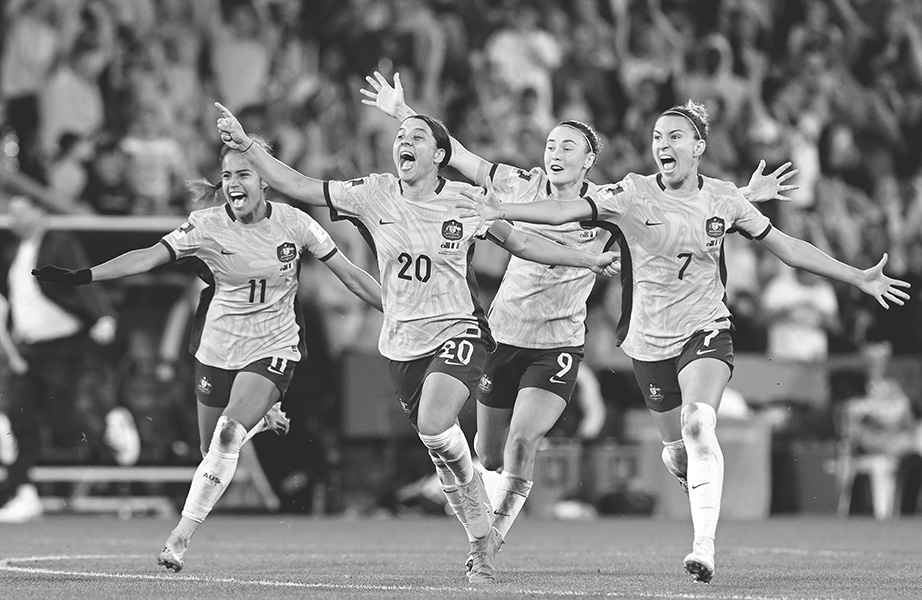
Theme: Catching the bug
Discovery: The 2023 Women’s World Cup was the gateway for new Matildas die-hards
Eight of the 12 participants either discovered the Matildas during the 2023 Women’s World Cup, or converted from vague awareness to super-fandom during the tournament. At least two only tuned in as late as the quarter-final against France.
Most did not have a history of sports fandom.
Several mentioned that their tween-aged children (girls and boys, usually grassroots players) originally prompted them to go to a match or fan site. Others somewhat stumbled onto the broadcast, which highlighted the importance of accessible coverage.
Epiphany: The spectacle and groundswell of the tournament – and especially its meaning for women – got them hooked
Key quotes:
“Something happened in me where I just thought, holy shit. I feel something. It was like this awakening. I’d never really seen powerful women in sports before. I was just mesmerised by how fearless they were.”
“I was watching an episode of Gordon Ramsay that night and changed the channel right before the penalty shootout. I was like, oh, yeah, this is on. Go, women!”
“It was very moving. Growing up, I never had teams like that to follow. I never played sport apart from in the schoolground. So to be a part of that the groundswell behind them. Also, the way it’s cut across all ages, male and female, I think it’s just been a really a uniting movement.”
“It gets under your skin and you just want to be part of it somehow.”
Commitment: Support has sustained or escalated since the World Cup
Despite most not previously being football or sports fans, the participants have escalated support for the Matildas and women’s football since the World Cup. This sample has survivor bias, but none had lapsed or lost ‘the bug’. Actions include:
- Attending more Matildas matches and open training sessions, including interstate and overseas (planning on Olympics)
- Watching documentaries, joining social media groups, listening to podcasts
- Traveling to the UK to watch WSL, and watching WSL and NWSL on TV
- Becoming ALW members
- Recruiting others into fandom
Key quotes:
“Football has been woven into our lives as a really positive family experience. We have a family [ALW] membership. I listened to probably three hours of podcasts on women’s football a week. I now subscribe to Optus Sport. It’s just become something that I never knew that there was this side to me before, and I just can’t let it go.”
“I bought myself a [Sydney FC] membership, got my nephews the kids passes, and then I’ve gotten all my sister and brother-in-law and my mum into it. I’m going to France. I’m so in. It’s really taken over my life, massively.”
Theme: Drivers to fandom (what is it about this team?)
Player stories: Connecting with the Matildas’ personalities
Every single participant talked about connecting with the individual people behind the shirt. The aspects of the players’ personalities which resonated were their humility, authenticity, and the theme of individual and collective journeys and progress. There was also a lot of interest, especially among younger relatives, in following the players’ club careers and relationships.
Several described the players as “accessible”, with this being achieved through documentaries, social media, interviews, and in-person fan interactions.
Key quotes:
“They are great talent on and off the pitch. It’s very real. It’s very humble. They’ve not entered this sport as superstars. Who they are as people really helps you anchor in emotionally to this team and stay there. You want to see them succeed as human beings beyond just representing Australia at the highest levels … just them, the people.”
“[Football Australia] have been very clever, the strategy of making them as accessible as they are. You think that you could be friends with them and you’d enjoy their company, you’d love to have them around. They’ve really humanised them so they’re not just players on a field.”
“[Stepdaughter fan] is player-specific rather than team and community-focused. She knows everyone on the team. She knows what other clubs they play for when they’re not representing Australia. She knows who they’re dating or what the rumours of who’s dating who is. And she is so invested in the individual players’ stories and who they are as people. I think that drives a lot of her passion.”
Family: The players are role models, and the team is a vehicle for families to connect
The players are seen to embody values and model behaviours which provide a positive influence on young fans and old. Examples:
- Mary Fowler wearing her signature gloves and headband, because those suit the way she wants to feel as she plays, seen as “a powerful and inspirational example for a family with neurodivergence”
- Michelle Heyman’s determination to get back to the top seen as inspirational for women hitting a second peak in their work lives
- Lydia Williams being a strong and proud Indigenous woman and leader
- Players being out, proud, and successful LGBT+ icons
- Young boys looking up to world class women players as the football heroes they want to emulate
Further to that, several participants have shared their fan journeys with their children or other family members. Football loving or playing kids were often the instigators of support and providers of expert knowledge about the team.
Key quotes:
“I absolutely would say that I’m a big Tillies fan now, and it’s lovely to have that to share with the kids. And it’s lovely for them to see me excited about sport because it’s definitely not something that I cared about nearly as much before.”
“Given that my introduction to Tillies passion came through a young person in my life, I think initially a lot of that excitement, passion was borrowed from her. That was something so important to her that my girlfriend and I created opportunities for her to experience that more.”
Unity and legacy: Working together towards a “higher purpose”
At least four fans mentioned that the Matildas’ unity, togetherness, and teamwork, on and off the pitch, as an appealing aspect. This unity is seen as being in pursuit of a “higher purpose” or desire to create a legacy beyond results. One fan positively compared the Matildas’ team spirit and mission with the USWNT’s more cutthroat, results-focused culture, as observed through their respective docuseries.
Key quotes:
“It’s the unity of the team. It’s not just the players on the field, but everybody behind the scenes as well. The hard work behind the scenes has [made] them as strong, as confident, and as emotionally stable and powerful on the field as they can be. That’s everyone working together for that final goal.”
“It’s absolutely a team that’s larger than the team that you just see on the field … it’s not just a few golden heroes. It’s that whole ‘we are the Matildas’, and it’s all of them.”
“The fact that we got fourth and it still was a transformational moment. I think the Matildas, to me, seem more focused on building something lasting, not necessarily being the best, but to change the game. They’re game changers. They don’t need to be winners to be game changers. They just are.”
Representation: The Matildas as an attractive metaphor for social progress
The Matildas are seen as standard-bearers for women and the LGBT+ community. The team’s success reflects the progress of those groups. That success can be on-field results, but also achieving higher pay and conditions, and achieving legitimacy by attracting unprecedented crowds and media attention.
None of the fans mentioned this as an explicit message that has been delivered by the team – it’s more symbolic and inherently felt. It was expressed as “being part of something” and “belonging”, which captures a sense of collective ownership and inclusion (as opposed to a passive ‘spectator sport’). It is also not to the exclusion of other groups – the Matildas are seen as a team for everyone, whereas men’s sports are more for men.
Key quotes:
“The rise of the Tillies is on the back of a larger cultural movement in women’s equality. We’re seeing that in multiple different sectors: employment, women’s rights, focus on safety and women in relationships and so forth. The Tillies are like the poster girls of that. They’re there to show young women you can achieve amazing things in your life. And I think that’s where it really hits me hard is that amazing things are possible for you as a young woman.”
“The Women’s World Cup games were just like… I cannot believe there are so many people who have turned out for a women’s sporting team. Those early games felt a lot like: ‘We’re all here. I didn’t think you would be here.’ And we were like: ‘Yeah, we all came.’ It just felt like a landmark moment.”
“A lot of it is their personalities, but also the inclusivity of the LGBTQ+ community that really hooks people in. And it’s good to see that representation in a sport at a national level that you don’t really see.”
“Sam Kerr during the World Cup was a big draw just because of her personality and her character. But for me as well, I’m queer, so being a lesbian, it is nice to just see that representation, especially because I don’t feel like we get it a lot in fictional media that’s really accessible. There’s just something really nice about being able to just support people from my community.”
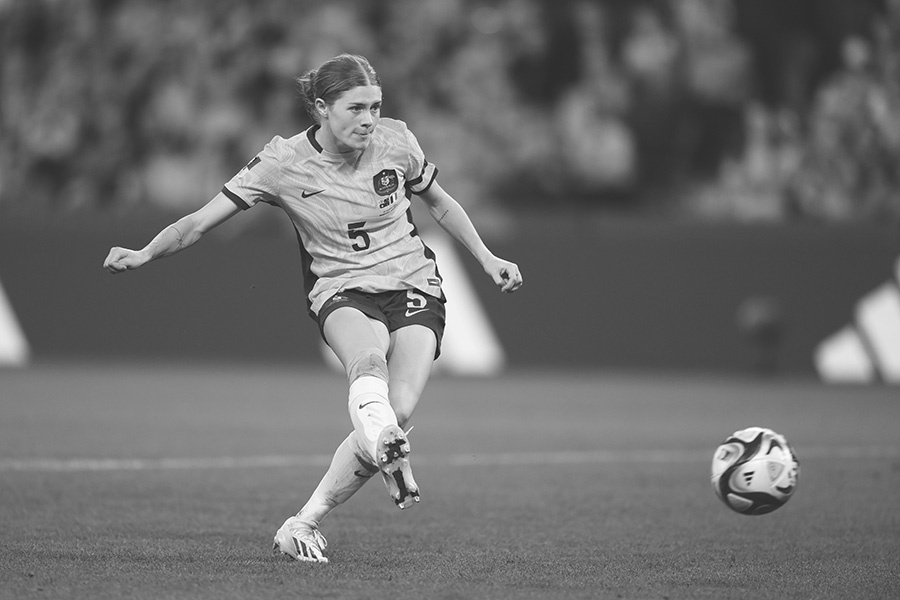
Theme: Media consumption
Learning from scratch: Explanatory and non-judgmental information sources are appreciated
For most of the participants, their sudden passion exceeded their knowledge. There was a lot to learn about the rules, the football landscape (clubs, leagues, internationals, women’s v men’s), the intricacies of performance, tactics, form, selection, and so on.
They appreciated sources of information which were explanatory and non-judgmental towards newcomers. For example, one mentioned a women’s football podcast where one co-host was an expert and the other wasn’t, so the discussion catered to all levels. They took cues from media figures such as Craig Foster and Samantha Maiden, and deferred to certain posters in their Facebook groups who would explain on-field aspects of the players’ performances or careers.
Social media and pod- and vodcasts were the key channels used for this purpose.
Key quotes:
“[re: a Matildas Facebook group] There’s just so much information and everyone’s great. It’s a great community, and there’s no stupid questions.”
Player stories: Docuseries and social accounts provide off-field access
There was also a strong attraction to channels which provided access to the players’ personal stories, such as the various docuseries and individual social media accounts. Seven of the 12 participants mentioned watching Matildas documentaries.
One’s partner allowed her 12-year-old daughter access to Instagram solely for the purpose of following the Matildas.
Key quotes:
“I follow all the Instagram pages, know every detail about their lives.”
“I’ve watched all the documentaries, not just about the Matildas, but Welcome to Wrexham, the Lionesses documentary, the Angel City documentary. They are such a great gateway. So much of it about it is who the people are and making you care about it. That has made me viciously connect to this soccer team in Wales … why would I ever care about them? But I care about them because of this documentary.”
Broadcast and streaming: Women’s football can drive subscriptions
Around half of the participants mentioned subscription services they had joined specifically to watch women’s football content, from Paramount+ for the ALW, to Optus Sport for WSL and NWSL, and Stan for the Trailblazers documentary.
Mainstream fail: When mainstream media was mentioned, it was criticised
When mainstream news was mentioned, which was rarely, it was criticised for not giving enough coverage to women’s sport. ABC News Breakfast and print newspapers were namechecked in this regard. Mainstream media or television broadcasts were not important sources of information about the Matildas.
Theme: Attending matches
Safety: An absence of the perceived toxicity and aggression of men’s sport
The safety of the environment at women’s football was explicitly raised by two thirds of the participants. Matildas matches feel welcoming and inclusive for women, families, and LGBT+ people. The vibe feels positive and supportive. There’s less swearing and abuse. This stands in contrast to men’s football or other sports like AFL. The way the match itself is played, in a tough but fair way with less violence, adds to this theme.
Key quotes:
“I just absolutely love how the culture fits me as a person. I’m not an aggressive person, but boy, I can scream my lungs out if I care about something. But I don’t do it with the male football geezer culture… It’s a family place. It’s full of energy. It’s warm and welcoming. People chat to each other in the seats. People offer each other chocolate and stuff. People are now swapping bracelets and stuff. It’s a female and family-driven culture. And also safe LGBTQI+ people. Yeah, it’s good.”
“It’s a predominantly women-based environment. It feels safe … I actually love seeing the boys and the men there, too, and everyone’s cheering them on. But you’ve got less abuse being called out. You’ve got better language. It’s a happier atmosphere, so there’s just less argy bargy and all of that.”
“Going to the games, it feels safe, which it doesn’t always when you’re talking about men’s football or men’s AFL, where there’s a lot of slurs going around. For me, that was a big thing. I kept seeing people being like, The Matildas are one of the gayest national teams. It raised my eyes that I’m like, ‘Oh, this is my community. I want to support them, not just because they’re women, not just because they’re Australian, but they’re actually part of my community, and I want to support that and see them do well for that reason as well.”
Atmosphere and fan culture: A new way, borrowing from men’s football and Taylor Swift
As it grows, women’s football appears to be finding its way to its own unique fan culture. There’s a live debate about atmosphere and active support, with respondents generally appreciating the noise and chanting at the Women’s World Cup (a la men’s football), but accepting that some people might be turned off by too much intensity. Two referenced a social media video by journalist Samantha Lewis that defended Matildas matches against criticisms of being too quiet. The central theme across comments was that all types of fans should feel included or catered to, or that a balance should be struck.
A community subculture of crafting and gifting between fans has evolved. Similar to Taylor Swift concerts, Tillies fans make bracelets and other DIY merch to trade with other fans. One participant had made her own range of Matildas Barbie dolls.
Matchdays as events: It’s about more than 90 minutes on the pitch
Activities and entertainment around the match were seen as important, including opportunities to connect with the players directly.
Key quotes:
“The feeling of the music and all that stuff, that real pump up exciting vibe. That’s something that I also noticed when I went to the Angel City game in America. That wasn’t a World Cup, that was just one of their regular games. But there’s music. It feels like a festival when you get there. There’s pop-ups, there’s things, there’s face painting. All the extra things that comes along with the experience of going to the game, which the Matildas I’ve noticed also have as well. So it’s not just the game, but it’s the lead up to the game. Let’s make sure you have a really good time while you’re here. I think all that stuff really helps to create the exciting feeling in the lead up to the game as well.”
“After the game, you know they’re going to go up and talk to the crowd and be very generous with their time. They seem more generous than perhaps I’ve seen within male sports. They all want to engage with the fans, and particularly the young fans.”
“Everything all around the outside of the stadium as well as inside. The big thing of the players telling the story of Lydia. There’s so much storytelling even at the matches.”
Part Two: A-League Women
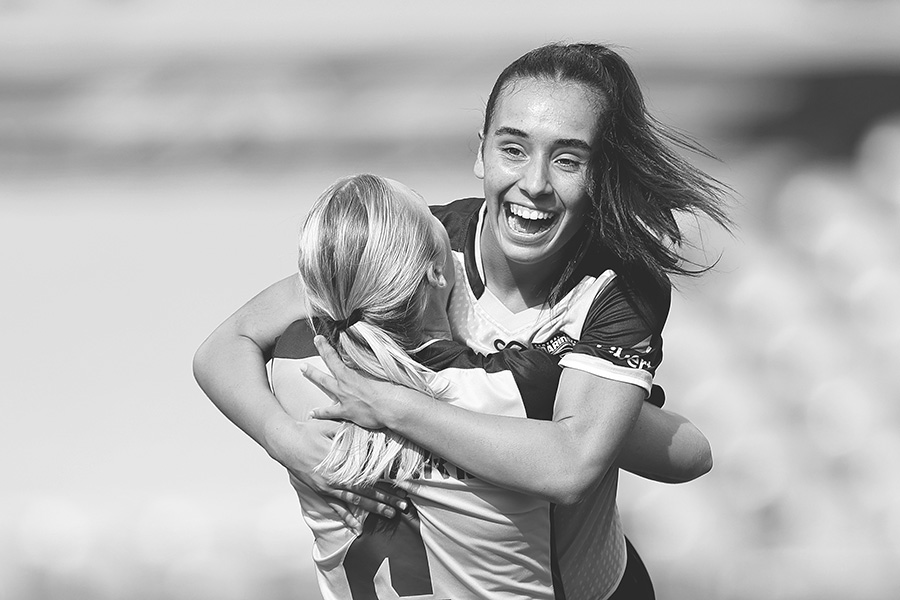
Theme: Awareness
Conversion: Around half of the participants had become regular ALW fans since WWC23
Five of the 12 participants had gone on to start attending ALW matches regularly in 2023-24. Two of these referenced a social media post by Craig Foster urging people to continue to support women’s football post-WWC23 by supporting an ALW team, citing the practical advice in his call to action.
Six of the 12 had partial awareness of the ALW, generally through its connections to the Matildas. One watched the All-Stars play Arsenal. One went to a few Brisbane Roar games “to help out the A-League”, and one went to a few Newcastle Jets games when Emily van Egmond was there.
The other fan was a long-standing supporter of Australian women’s football so had prior awareness of the ALW. So, none were totally ignorant.
Key quotes:
“I just didn’t want it to be over. I googled podcasts and came across The Far Post, and I’ve been an avid listener ever since. And I remember seeing a social media post by Foz. He said, ‘if you want this wave to continue, join a club, go subscribe to the TV channel like Paramount Plus’. And I basically did it all. I’ve joined a club. I’ve been to ten A-League matches. I went and watched the Olympic Qualifiers. I went and watched the A-League All-Stars.”
“I think [Craig Foster’s] social post was good because it really just gave practical advice. If you want this to keep going and to feel this special, you do have to put your money and your time where your mouth is.”
Knowledge: It is hard to get basic information on the competition
Some of the fans admitted being ignorant of basic facts about the ALW. They would not be able to name many ALW teams, and did not know who broadcast the league. Some said that it was easier to find information about the A-League Men (ALM) when looking for the ALW.
Two said it was a missed opportunity not to advertise the local ALW team at Matildas matches in that city, making the point that they want to be led to the ‘next steps’ to take their support further.
Key quotes:
“I don’t think that there’s been as much information about when the women’s games are and when they play. And there’s just no way of easily finding that information. I did try and look. I don’t know if I looked in the right spot, but I could see the men’s draw and when men’s fixtures were, but not the women’s.”
“I have checked my emails. I haven’t got anything from Football Australia or Adelaide United or anything. I’m assuming that my details are now in a database, having bought Matildas tickets, having subscribed to get the notification of Matildas tickets. And I’ve received nothing about Adelaide United games, men or women that are on, or how I’d go about getting a membership. I would have thought that with the technology that’s available to marketers now, that I would have had a couple of emails then in my mailbox saying, hey, look, this is the next step, or this is how you can support local grassroots football or your local A-League team, or whatever.”
“[After attending a Matildas match] if you love women playing this game, [tell me] this is where to next, or based on our clever algorithms, your local club is this one. Do you know how to find the membership for next? Just something, a little invitation back for more. Or, we’re partners with Optus, so you can now watch these games in this way. Just give us that little bit of how to get more. Thanks for coming, and here’s your invitation for the next date.”
Theme: Connection to Matildas
Matildas factor: The Matildas are a key gateway to supporting the ALW
By far the most common driver for these fans to initially get interested in the ALW was any connection to the Matildas (noting here that this research targeted Matildas fans).
This connection took various forms. Obviously, there was direct interest in clubs and matches where Matildas were playing. Cortnee Vine’s presence at Sydney FC acted as an onramp for several fans to become members there (along with their families), while another went to the few Newcastle Jets matches when Emily van Egmond played a guest stint (but not other Jets matches).
At the same time, a shared view was that the presence of Matildas was not a prerequisite for continued support. Sydney FC fans would probably stay so after Vine’s departure to the US, for example.
Key quotes:
“The kids said ‘this would be a way to meet a Matilda in a less crowded environment’.”
“We’re a bit upset that Cortnee was leaving Sydney FC, but I think I’ll just now [also] follow North Carolina Courage … You have a really strong connection to [Sydney FC/ALW]. And there’s not really any going back on this.”
Incubator: Watching the next generation of Matildas in the flesh is a huge appeal
The idea of the ALW being an incubator for the next generation of Matildas also had widespread appeal among a majority of the participants. There was a sense of ownership or involvement in the players’ journeys. The idea of “being there from the beginning” when the players achieved great things later was most exciting.
Key quotes:
“I went to all of Brisbane Roar’s games here in Melbourne just by coincidence. Every game, [Sharn Freier] was so impressive. Then seeing her get that call up, I felt like ‘that’s my child’ or something.”
“Obviously, I adore all the Matildas, but there’s something so special watching these 18-, 19-year-olds play that you’re like, ‘they are going to be someone for our national team one day’. Eighteen or 24 months ago, Kyra Cooney-Cross was at Melbourne Victory, and you’re like, ‘look at her now’. It’s almost more exciting to see these girls who are up and coming and you think, ‘this could be our captain one day’. ‘This person could be scoring for us in the next World Cup’ because there’s just so much homegrown talent that are possible future Matildas.”
“I just love being at the coalface of the young talent coming up now. It is just really special. You see someone like Daniela Galic, you go, ‘when you get your international cap, I’ve been there from the beginning’.”
Theme: Promotion and media
Player stories: As with the Matildas, storytelling is critical to building connection to the ALW
Just as player stories were a hook for the Matildas, the participants said that understanding the personalities and personal journeys of ALW players would be critical to building a lasting emotional connection to the league.
Some compelling stories mentioned were Michelle Heyman’s resurgence, and international players such as Kayla Morrison and Sarina Bolden (“what draws them to the A-League?”).
Several mentioned that they did not have a connection to the league because of a lack of storytelling or available information on the players. They urged the use of social media or documentaries to tell those stories. There was sympathy that part-time athletes were not able to provide the same access to their lives as the fully professional Matildas.
“I work in communications. People make decisions emotionally and back them up rationally. I think more investment could be made into the emotional connection with the A-League players… I think what’s really worked with the Matildas is we really feel like we know who they are, and then we just buckle up and get on the journey with them and see where they go. You’ve got to find the buckle up moment with A-League so people feel emotionally invested to see where the players go, because at the end of the day, the league is the players.”
“As opposed to Matildas where you know the players, I don’t know who the players are. There’s not that much out there about them. Again, that’s completely fair enough. But it was something that I did think about when I thought, why do I feel so connected to that team? And maybe not necessarily as connected to my local team, which would be Western Sydney, even though I really want to.”
“It’s the personality of the players. You don’t get to see that like you do with the Matildas. You can’t relate to them on a deeper level. Obviously, if you go and follow their social media, but some of these people still work part-time jobs because they don’t get much money.”
Broadcast: The quality and consistency of ALW match broadcasts is a weakness
Every comment about the ALW broadcast was negative.
The most common feedback was that the position of the camera showed an empty grandstand on the far side, underrepresenting the level of actual support and therefore undercutting the women’s desire to prove their legitimacy to potential detractors.
Other aspects mentioned were that the coverage did not clearly show the emotions of the players or make it easy to see the ball.
Key quotes:
“It would be really nice if the cameras were on the other side of the field showing the spectators rather than showing empty seats, because everyone goes, ‘who wants to go see soccer’?”
“The TV coverage isn’t very good quality, especially at Ballymore. The stand was full, but the cameras were on the same side. So on the telly, you’ve got this empty rugby union stadium, which doesn’t look very exciting.”
“The TV coverage I found was variable. I watched the away games for Sydney FC, and it was really hard to watch the game. I just couldn’t see the ball a lot of the time. And you didn’t really have the stadium experience, of course, because you weren’t there. So it did make it feel like a little bit of a waste of time.”
Social media: Standalone accounts for women’s teams are preferred
The participants wanted to see ALW teams have separate accounts for their women’s teams, to give the teams sufficient focus and also to protect against toxic comments from men.
Two recommended Western Sydney’s TikTok as a good example, even though neither were fans of that club.
The types of content they wanted to see were short pieces which help you get to know the players.
Key quotes:
“Another good idea that the A-League Women could have is the Tillies did like a ‘Meet the Tillies in 90 seconds’ thing, and it just showed you who they were in such a short period of time. Even when they were in Melbourne, they could have done that with the All-Star team.”
“I don’t want to go on posts celebrating a women’s team win and there’s a bunch of men’s fans in the comments being like ‘Who even watches this? Who cares?’. WSW TikTok is social media done right.”
“One of the worst days I ever had on the internet was when they tried to announce a pride round on social media. The comments were just so hideous that I just was like, how can anyone feel any pride in this week? That for me personally was a really upsetting day. I just was like, I hate this. This is I wish the women had their own page because I guarantee the men won’t be following it.”
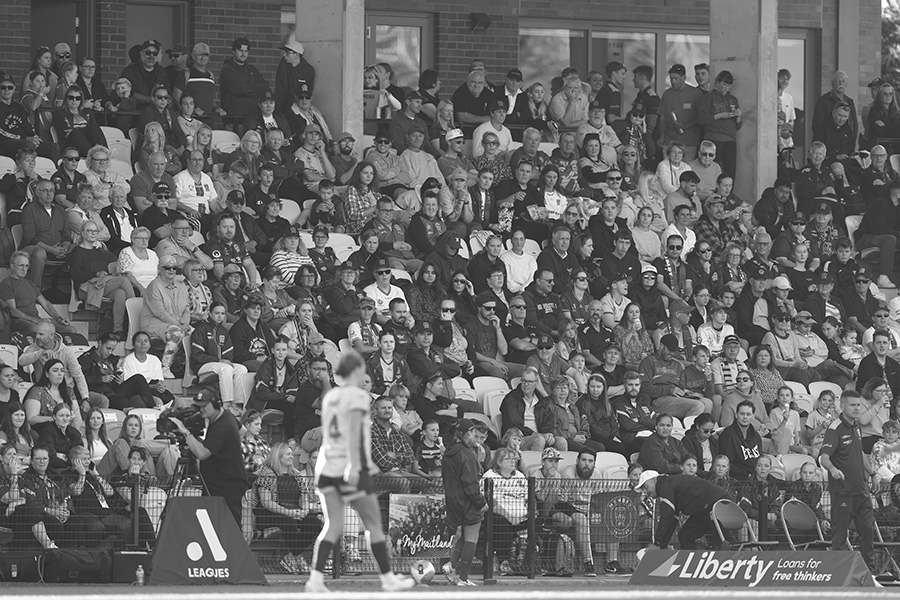
Theme: Attending matches
Venues: Many current stadia are inaccessible or wrong-sized, but Leichhardt works
Based on the discussions, the ideal ALW venue should be intimate, providing a good atmosphere and close proximity to the players. It should be family-friendly and accessibly located, ideally connected by public transport. Sydney’s Leichhardt Oval was regarded as ideal for fans by several participants, and Newcastle’s No.2 Sportsground was also liked. The grass hills at these venues were plusses, because it was relaxed and the kids could run around.
Melbourne City’s Casey location (“a backwater”) and Western United’s Tarneit ground were seen as challenging to get to with a family, particularly from other parts of Melbourne. The lack of shade at Casey and others made attending through summer a bad experience.
The chopping and changing of home grounds throughout the season by clubs such as Brisbane Roar came up as a barrier to regularly attending.
Larger venues were not mentioned much, but Sydney FC matches at Allianz Stadium felt “slow” and “weird” due to the mismatch for the size of the crowd.
There was a feeling of a “lack of investment” in the fan experience due to the poor seating and amenities at some venues and the lack of activations and entertainment around the match itself.
Family-friendly: Affordable pricing and early-ish kick-off times work for the kids
The fans who had bought memberships or attended ALW matches felt the pricing was good value. This was appreciated when attending with families. One had an issue with regards to accessibility where one family member was in a wheelchair.
Late afternoon/early evening kick-off times were preferred, so that kids could get home not too late (noting that extreme heat did come up as a barrier also).
Key quotes:
“That price point is really attractive, and it’s been amazingly family friendly. It’s been like the times that they actually play are really, really good for just a fun day out at the sport.”
“I think I paid $90 for our membership, and that gave us access for four people for the whole A-League season to all the home games. And with many at AAMI Stadium. So the price point I found very appealing for that. And I’m also buying merch. I’m also buying food, hospitality. And so I do feel like I’m a financial participant as well.”
Theme: What should the ALW be?
Afterthought: Female fans are sensitive to the current lack of ‘care-factor’
When asked specifically, all the participants generally preferred the idea of clubs and a league that were independent from the men’s A-League and clubs.
The perceived toxic vibe at men’s matches is discussed above. The other major driver underpinning this view is the feeling that the league is currently treated as an “afterthought”, with that word coming up in two of the three sessions.
Given that they were newcomers to the ALW, the participants had nuanced views on the idea of independence, because they are aware of the two leading women’s leagues, the NWSL and the WSL, through the Matildas playing there. Those leagues have independent and dual-club structures, respectively (although the WSL is now governed separately). So the fans did see the benefits of being attached to the men for a club like Arsenal. Overall, though, they preferred the idea of a bespoke, standalone offering, which could fulfil a greater potential out of the men’s shadow.
One example cited was the presentation of Melbourne City Women’s Premiership trophy at half-time during a men’s match, with the broadcast coverage not breaking away to focus on it. Other examples were the lack of (timely) available merch, food vendors not being open, and the lower standard of matchday facilities and amenities generally.
As a suggestion of how to make women’s fans specifically feel valued, one fan said it would be nice to receive a thank you email after attending a Matildas match.
The participants who were already members of dual-clubs said they would have no hesitation transitioning to a new entity, because they were attached to the players, not the badge.
Key quotes:
“Let’s dare to dream and have them separate. And the women’s will be more popular than the men’s.”
“It feels really awkward to be partnered with the men’s side of the club, if I’m being really honest. The vast majority of the people who turn up to the women’s games that I end up talking to have no interest in – almost disdain of the men’s side. It just feels silly to be playing second fiddle to the men’s side of the club when that’s not the side that’s doing super well or it’s not the side of football in Australia that’s doing well.”
“When I saw the NWSL for the first time and when I saw the way that college soccer in America is done, I was like, that’s the way it should be done. If I were talking about what feels right, in terms of a cultural identity as a fan, yeah, being the ‘other’ team for the men’s team just doesn’t feel right.”
“Whether it be by the club or by a league, it just feels like the women’s supporter experience is really quite second rate. I’ve had a great time, but I do feel like the women’s league is a real afterthought.”
“I’m not necessarily a rusted on Melbourne City supporter, but I love the players. If I could see them in some other configuration, go for it.”
“I don’t think the male teams and their branding have any positive influence or input on the female side whatsoever. If anything, it’s to their detriment. I think, post-World Cup in Australia, standalone A-League Women’s could be amazing.”
“In an ideal world, I love the idea of them being independent clubs and having a women’s league like what happens in the NWSL. I get the impression that we’re very much an afterthought. We’re on the same level as the boys’ academy team that are a bunch of teenagers not even playing professional football.”
“What it comes down to is feeling like this is a league that we are proud of. We are backing this league and we are proud of this league and you should back it, too.”
Professionalism: The semi-pro nature of the players’ careers made them harder to connect to
While lacking knowledge of the ALW generally, the participants were well aware that the players were earning sub-professional salaries and often working other jobs.
This was seen as being to the detriment of the on-field quality of play, particularly compared to NWSL and WSL. It was also seen as a barrier to connecting with the players as elite athletes.
Conditions for players were also seen as symbolic of whether the league is valued by those running it, in the sense of it being a premium product and also whether it treated women the right way.
Key quotes:
“I don’t think just championing inclusion and championing feminism would be enough to sell it. I think we would actually have to see the product and the professionalism take a step up rather than people being on like part-time, no jobs and that sort of thing.”
“I think the level of play needs to be closer to the level of what we see from overseas leagues.”
“There’s just so much about it not being a fully properly professional league that impacts the whole experience. You can see the difference. I’m much more engaged in the WSL than I am the A-League, even though I go to games here. Not having the remuneration for the players means that they’re also a lot younger. The quality of the football is not the same, and then everything around it. I feel bad, but I can find A-League games frustrating sometimes.”
“It’s the personality of the players. Some of these people still work part-time jobs because they don’t get much money. So I think it’s just not being able to relate to them on the level that you do get to relate with the Matildas players.”
“It’s the higher pace. I think it would be hard to have to work part-time and then go and throw the extra of your life into this game where you’re putting your body on the line and you’re not getting much compensation back for it.”
Values: The league should actively promote social justice causes
There were two streams with regard to what values the competition should embody.
Firstly, there was a widespread preference for the league to support social justice causes, such as by having pride rounds and Indigenous rounds. There was frustration that the men’s teams had apparently compromised the delivery of the pride round.
Secondly, the league should reflect the Matildas’ core values of unity, purpose, progress, and teamwork. One example of this was the suggestion that fans of all clubs should be fundraising to support Canberra United’s ongoing existence.
Key quotes:
“It [should be] a league that isn’t afraid to do things like pride rounds, Indigenous rounds, stuff that really builds community. Any time I’ve been to a women’s AFL game, it’s because there’s a pride round on [or] it’s an Indigenous game. I’m going to go to that, because of that event around a game.”
“The values that have been put forward in the two Matildas’ documentaries need to be front and centre for whatever league would be formed.”
“Build off those values that we all were interested in that Matildas embody, the anti-racism, anti-homophobia, all of those things and really build out the inclusion, really focus on that part.”
